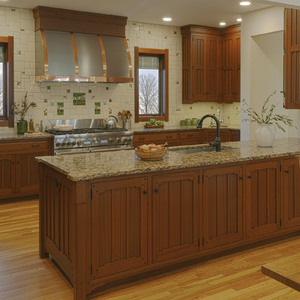Synopsis: When a woodworker was asked to redesign the interior of a condo, the main question was what to do with all the clients’ books. He answered with an attractive wall unit that covers the 30-ft. length fo the living room wall.
A writer once said that there’s no furniture as charming as books. Too often, though, the furniture made for books barely rises above the level of utility. But high-grade materials, a thoughtful design and attention to detail can turn what might have been little more than storage into a home’s focal point.
Such was the case when Robert Hillen of Interior Woodworking in Cincinnati was hired to redesign the interior of a condo. The new owners were trading down from a larger home, and though that meant shedding excess possessions, there was one thing they were unwilling to part with: their 360 lineal feet of books. In fact, they wanted room to expand it to 420 ft. Hillen’s design included a complete redo of the interior, but its centerpiece was a massive maple bookcase that covered 30 ft. of the living room wall.
Durable elegance
After completing the design, Hillen handed the project over to the company’s head woodworker, Bradd MacCallum. MacCallum, who spends the bulk of his time in the shop building custom furniture, has a head for numbers and a passion for accuracy. Everything was built in the shop, then assembled like a puzzle at the job site. This demanded both a great deal of planning and precise measurements. Many of the pieces were made to tolerances of 1/64-in.
Although the bookcase would be a dominant feature of the house, it couldn’t be overwhelming. Purpleheart detailing was used all around to this end, helping to make the bookcase an engaging piece of worksmanship, rather than an imposing mass of wood. The purpleheart’s deep red contrasts sharply with the blond maple of the shelves, while at the same time complementing the violet hue of the carpet. The details are where the furnituremaker’s hand really shows, enticing the observer to draw closer rather than forcing him to step back.
But if appearance was important, the weight of all those books meant that strength was crucial. Luckily, the condo had been built on a thick concrete slab, so floor strength wasn’t as much of a problem as the strength of the bookcase itself. Hillen specified a 5-in. thickness for the two center uprights, and 3 in. for the rest. Solid wood was out, though. Not only would solid maple be unreasonably expensive, but its weight would make the uprights too heavy to transport and install. MacCallum considered using wooden frames clad with 3/4-in plywood, but those would present similar problems. Finally, he hit upon a solution.

























